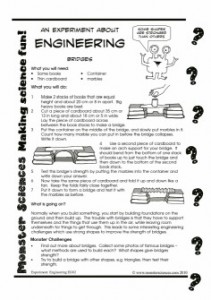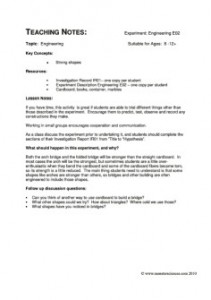A great engineering experiment where students can build and test the strength of different bridges.
 |
 |
What you will need:
- Some books
- Thin cardboard
- Container
- marbles
What you will do:
- Make 2 stacks of books that are equal height and about 20 cm or 8 in apart. Big heavy books are best.
- Cut a piece of cardboard about 35 cm or 13 in long and about 18 cm or 5 in wide. Lay the piece of cardboard across between the book stacks to make a bridge.
- Put the container on the middle of the bridge, and slowly put marbles in it. Count how many marble you can put in before the bridge collapses. Write it down.
- Use a second piece of cardboard to make an arch support for your bridge. It should bend from the bottom of one stack of books up to just touch the bridge and then down to the bottom of the second book stack..
- Test this bridge’s strength by putting the marbles into the container and write down your answer.
- Now take the same piece of cardboard and fold it up and down like a fan. Keep the folds fairly close together.
- Put it down to form a bridge and test it with the marbles as before.
What is going on?
Normally when you build something, you start by building foundations on the ground and then build up. The trouble with bridges is that they have to support themselves and the things that use them up in the air, while leaving room underneath for things to get through. This leads to some interesting engineering challenges which use strong shapes to improve the strength of bridges.
Monster Challenges:
- Find out more about bridges. Collect some photos of famous bridges – what methods are used to build each? What shapes give bridges strength?
- Try to build a bridge with other shapes, e.g. triangles, then test their strength.
Teaching Notes:
Topic:
Engineering
Key Concepts:
Strong shapes
Resources:
Investigation Record IR01– one copy per student
- Experiment Description Engineering E02 – one copy per student
- Cardboard, books, container, marbles
Lesson Notes:
If you have time, this activity is great if students are able to trial different things other than those described in the experiment. Encourage them to predict, test, observe and record any constructions they make.
Working in small groups encourages cooperation and communication.
As a class discuss the experiment prior to undertaking it, and students should complete the sections of their Investigation Report IR01 from ”Title to “Hypothesis”.
What should happen in this experiment, and why?
Both the arch bridge and the folded bridge will be stronger than the straight cardboard. In most cases the arch will be the strongest, but sometimes students are a little over-enthusiastic when they bend the cardboard and some of the cardboard fibers become torn, so its strength is a little reduced. The main thing students need to understand is that some shapes like arches are stronger than others, so bridges and other building are often engineered to include those shapes.
Follow up discussion questions:
Can you think of another way to use cardboard to build a bridge?
- What other shapes could we try? How about triangles? Where cold we use those?
- What shapes have you noticed in bridges?



